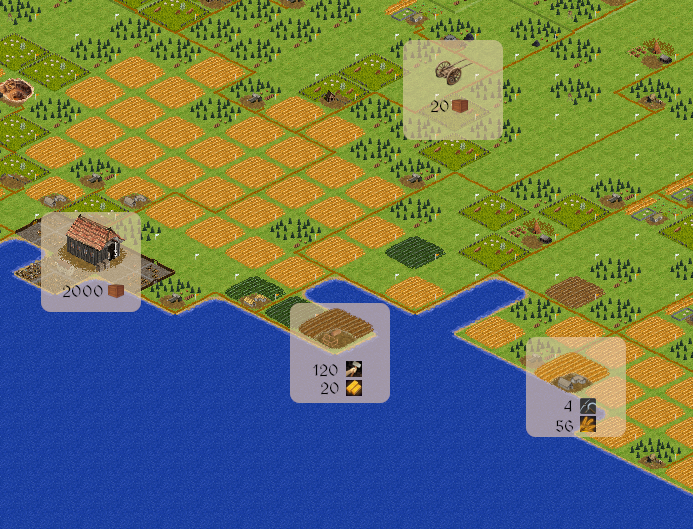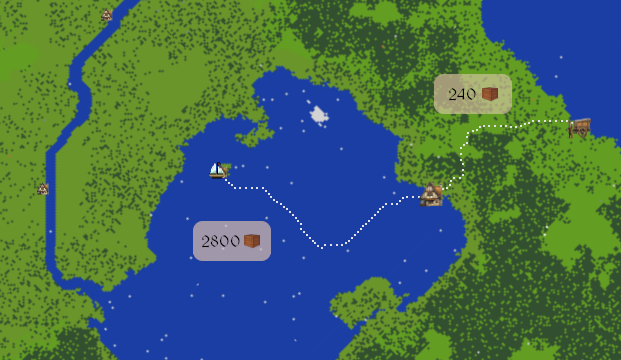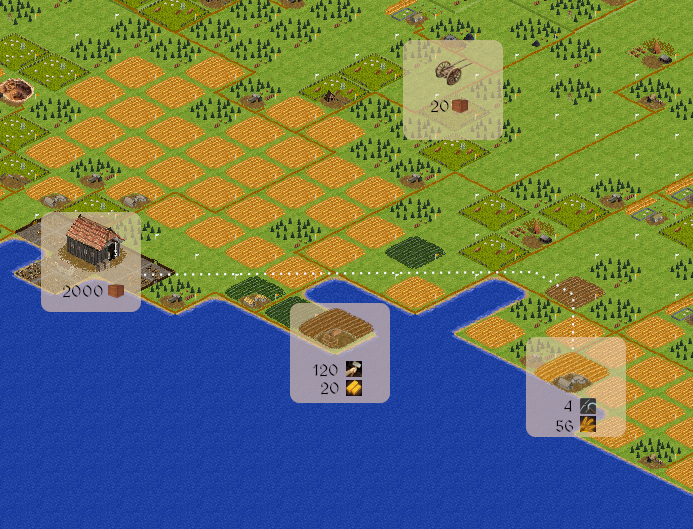Space occupied by a product
The space unit factors in both size and weight, and sometimes the fragility of a product.

Grain is measured in bushels, each of which weighs 56 lbs and takes 2 space. It resides somewhere in the middle of the range of transport cost, not extremely voluminous (like firewood) or extremely heavy (like lead bars), or particularly fragile (like sheets of windows).
Wherever grain is kept, this space needs to be allocated for it. If an attempt is made to obtain grain, say by putting a bid at a market, space for it needs to be reserved up-front. In the same way that you can't issue two orders using the same funds for payments, you can't double-book that space. This may be inconvenient if many orders are issued opportunistically, but it assures that if all the orders suddenly come through, you have the cash to pay and the space to store everything you just bought.
Location and types of storage space
There are four types of storage space in Mercatorio: warehousing, operation usage, construction materials and cargo.

Warehousing provides generic storage space in a town center. It can be freely allocated to various products and provides a convenient base for trading at the town market, buffering goods between steps in a production chain, or setting up trade routes with other towns. If we want to purchase 100 grain from the market, 200 space needs to be reserved (this happens automatically as long as there is free capacity in the storehouse or warehouse in question).
Operation usage is product specific and has fixed capacities related to the production method being employed. A grain farm that's not linked to a warehouse will purchase its own tools (if required by the production method), potentially keeping some buffer to smooth over supply disruptions. It can also store some amount of unsold grain. Products not related to the current production method can't be handled. There's a special case when production methods are changed, say we downgrade the farm to not use tools anymore or a carpentry switches from crafting furniture to making casks. In this case any left-overs from the previous production method will be sold back to the market behind the scenes and potentially at a discount.
Construction materials are not so much storage and consumption of materials. It does follow the same mechanics with the exceptions that materials can only flow into the project, and that it treats services like labour, which doesn't take up space or require capacity allocations, the same way as other products.
Lastly, cargo of carts or ships functions similarly as warehousing, providing generic storage space for any product, with the difference being that this storage can move around. Products can be purchased or transferred from a warehouse in one town, then brought to another town to be sold at the market there.
Trade routes
While a cart or ship can carry cargo from town to town and make money trading there, this doesn't scale to the level of a trade network. For that, you want to automate the transport by setting up a trade route.

Trade routes are orders for a cart or ship to move along a specified path again and again, shipping specified products from one place to another. Usually many trips can be made each turn, such that the total flow of goods becomes a multiple of the cargo space (in each direction). In your hometown the trade route will deliver or pick up at a designated storehouse or warehouse, in the other town it will trade at the market, similarly to how local trades are configured.
To take an example of an export route purchasing grain at your hometown market for export, you now need to allocate 2 space per grain of intermediary storage in the warehouse as well as 2 space of export capacity on a trade route to transport it to the other town. The grain will be purchased in one turn and picked up for export in the next turn. As always, it can be a good idea to allocate additional storage space and perhaps keep a few turns of export volume as a buffer against short term disruptions.
Note about paths and capacity
Be aware that the capacity of the trade route depends on the length and cost of the path it travels. In the above illustration the land route is following a close to optimal path (avoiding forest and inclines when possible) while the sea route is taking a unnecessary detour. It may not matter for such a short distance, as loading/unloading dominates travel-time, but for longer routes you will benefit from choosing a good path. In the extreme it may determine if a given town is within reach or not.
Also, ships obviously have both more capacity and range, translating to much lower transport cost. There are situations where this matters less, and on above illustration the land route may or may not be cheaper than taking the ship down the river and back down the coast (not fully visible in this cropped view), but in general a competitor with a sea route is going to beat your land route to the same destination.
Local delivery costs
Lastly, deliveries of goods from production buildings to storage or the market also has a cost, however this is somewhat simplified compared to full fledged trade routes.

Firstly, only the outputs delivered from the production building to the town center are counted. Inputs to the building (eg. tools to the farm) are usually smaller and are considered to be brought on the return trip for free.
Secondly, the carting service required for these deliveries is commodified and traded on the town market, standardized on the unit of one cartload (40 space -- this is a larger cart than the handcart used in the trade route) delivered from two miles away (16 tiles), such that production buildings can simply purchase what is needed together with the other inputs for their production. Buildings in the town center do not require any carting service. The carting service is covered in more details in the Carted into town article.

